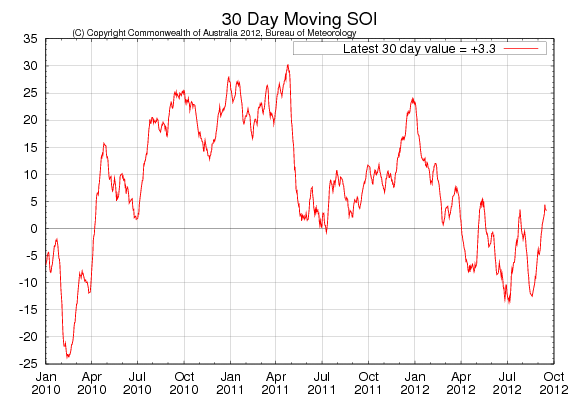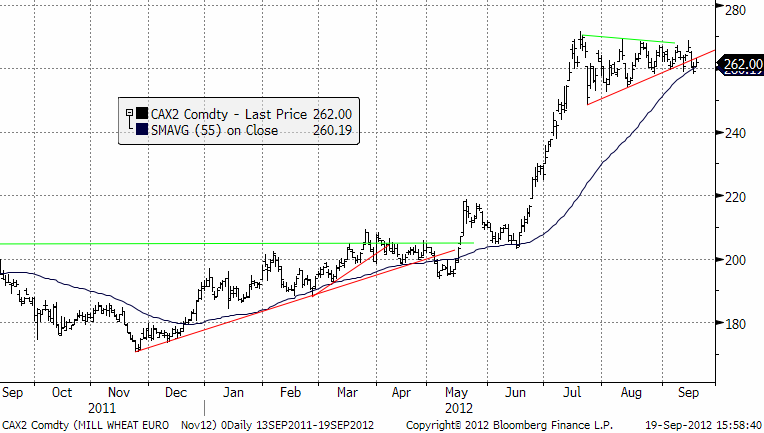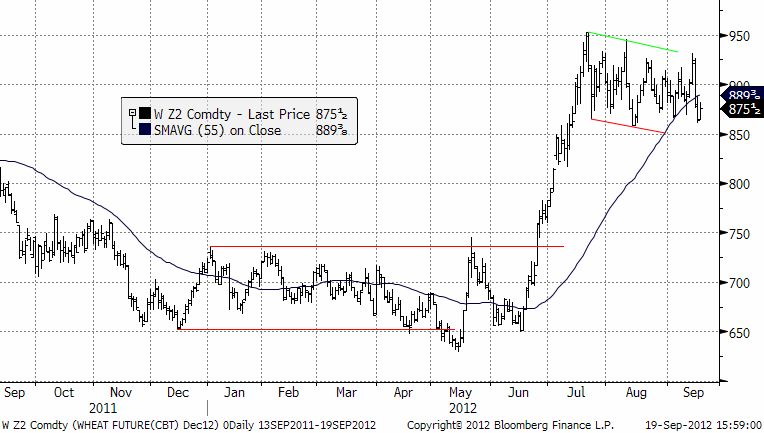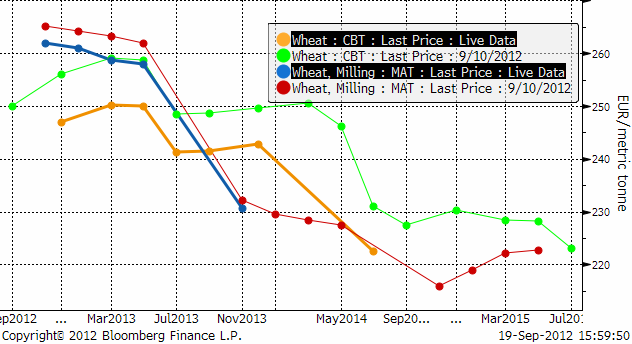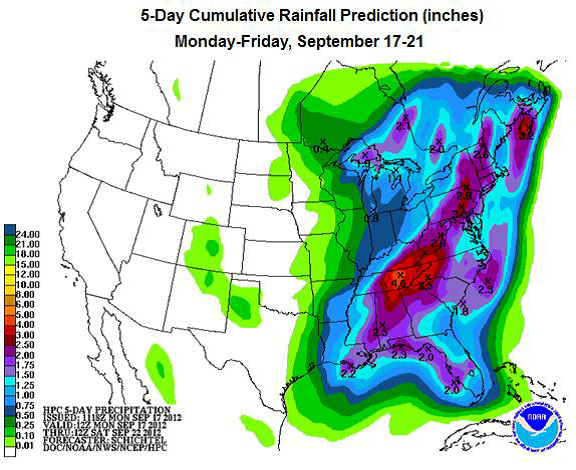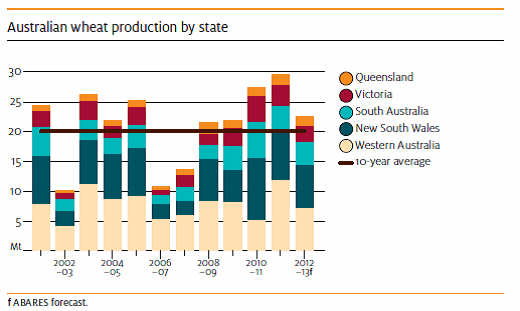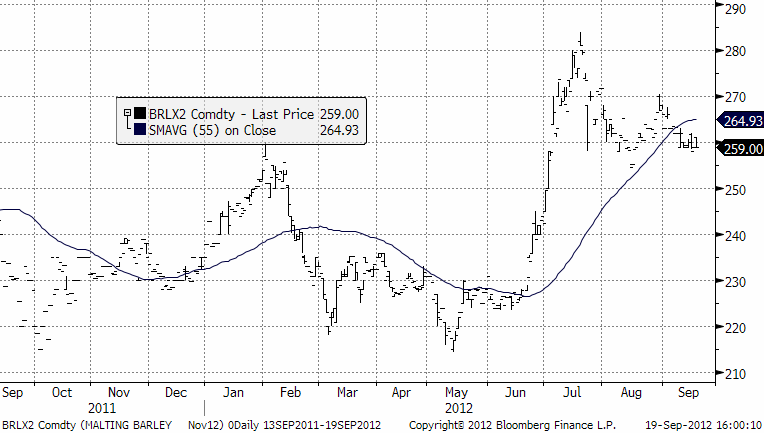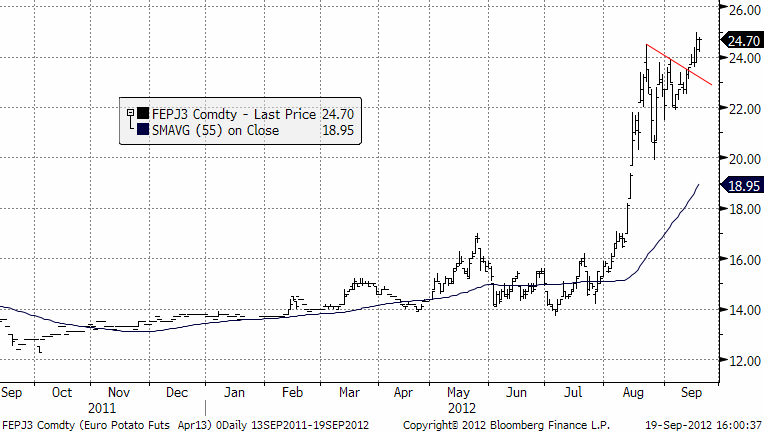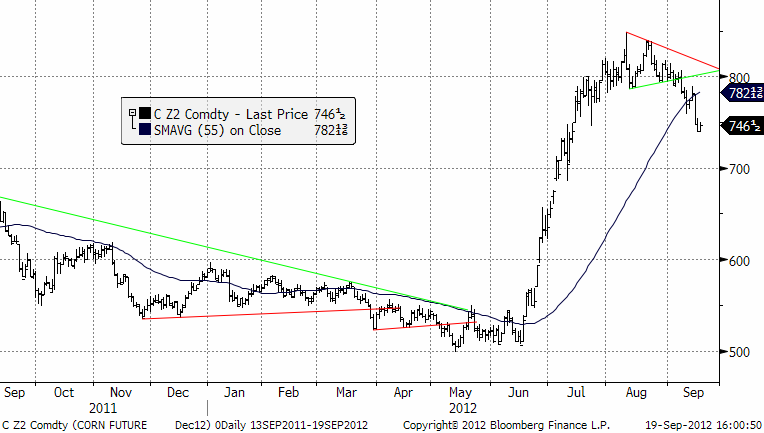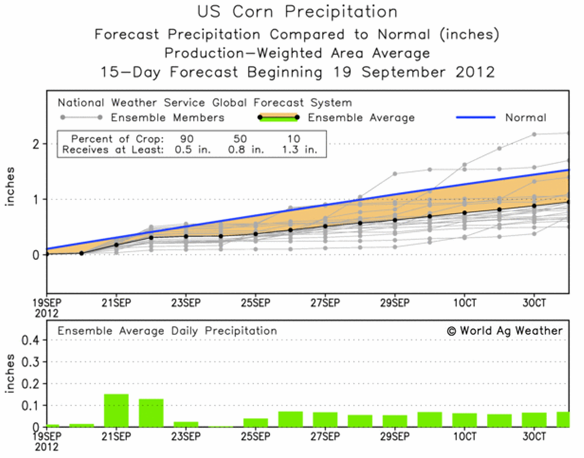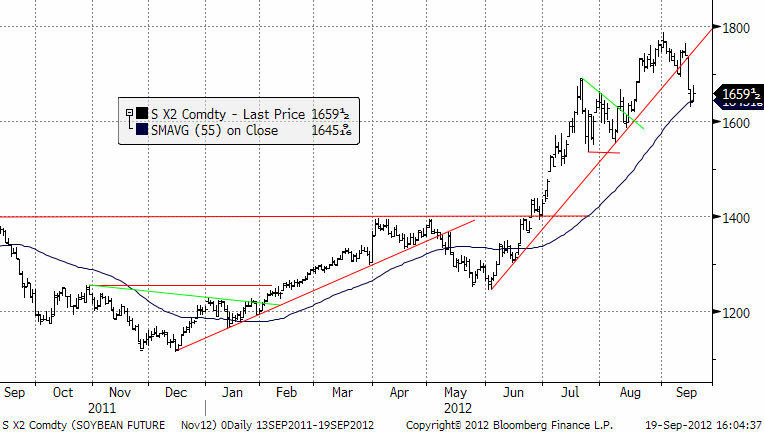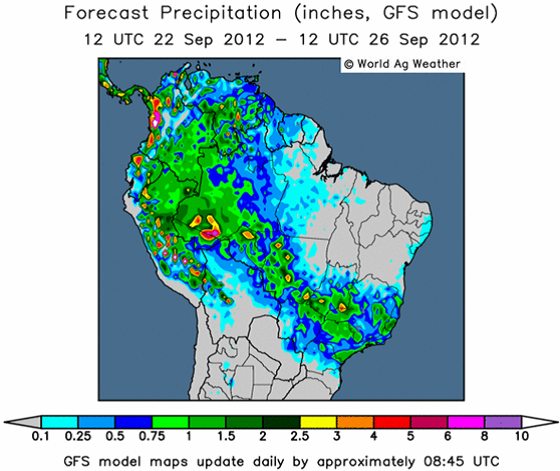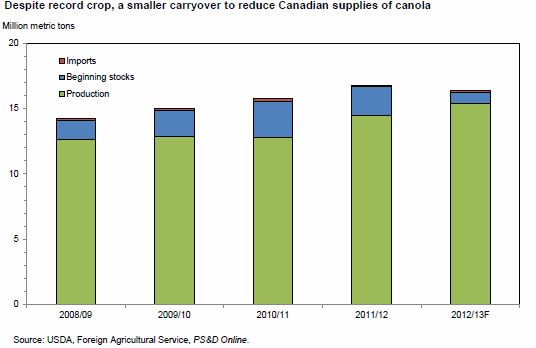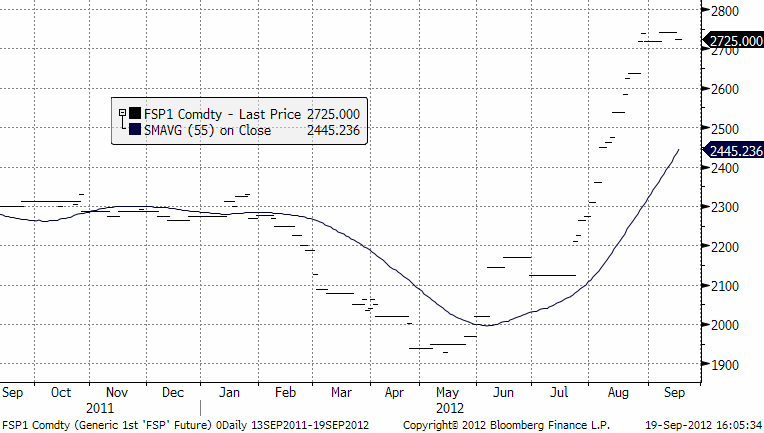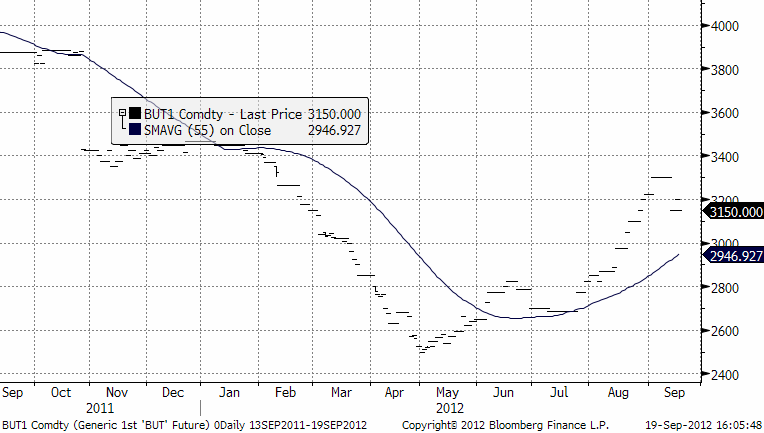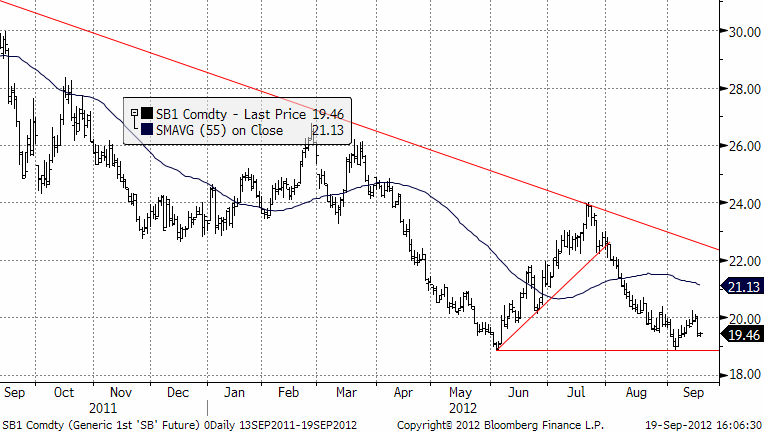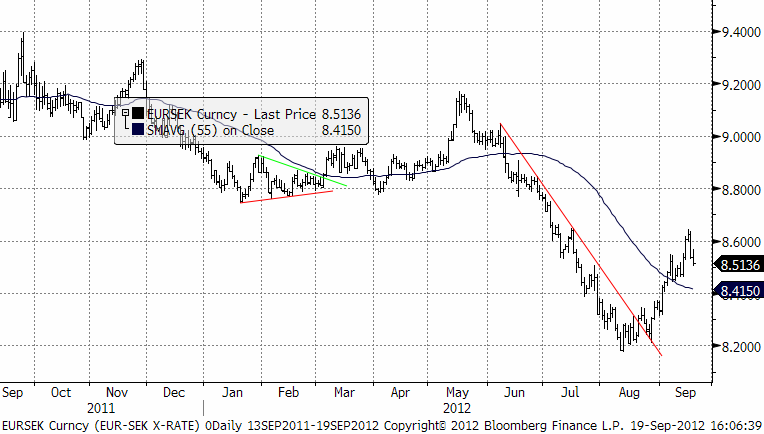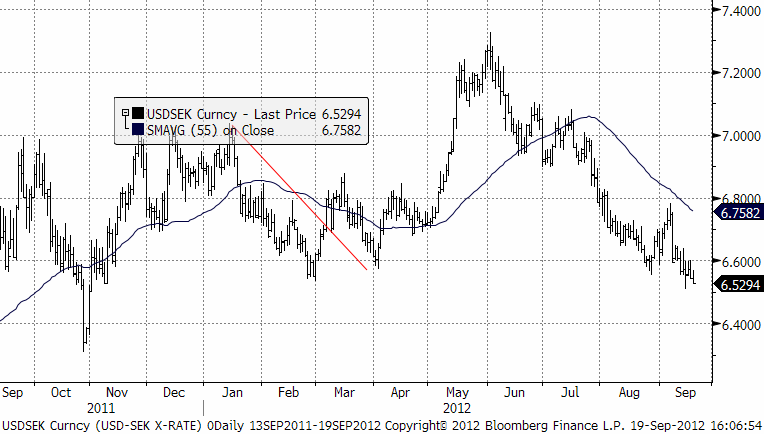Analys
SEB Jordbruksprodukter, 20 september 2012
 Vi ändrar rekommendationen för alla spannmål och oljeväxter till neutral, utom för majs, där vi rekommenderar en kort position. Potatis befinner sig dock i stigande trend, efter att just ha lämnat en konsolideringsfas. Priset på lean hogs har också stigit från botten på 70 cent, så vi går över till en neutral rekommendation efter en lång tid med säljrekommendation.
Vi ändrar rekommendationen för alla spannmål och oljeväxter till neutral, utom för majs, där vi rekommenderar en kort position. Potatis befinner sig dock i stigande trend, efter att just ha lämnat en konsolideringsfas. Priset på lean hogs har också stigit från botten på 70 cent, så vi går över till en neutral rekommendation efter en lång tid med säljrekommendation.
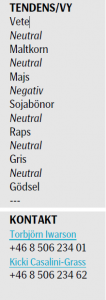 Politik
Politik
Frankrike har kallat till ett krismöte med G20’s jordbruksministrar i mitten av oktober i Rom på för att diskutera hur man ska kunna bromsa de kraftiga prissvängningarna i spannmålsmarknaden, efter att årets torka och rekordhöga priser har skapat nya farhågor om en global matkris. Uttalandet kom efter samtal mellan Frankrikes president Francois Hollande och Jose Graziano da Silva, generaldirektör för FN:s livsmedels- och jorbdruksorganisation (FAO). Flera förslag har lagts fram under de senaste dagarna, bland annat utveckling av strategiska lager och ett stopp i expanderingen av biobränsle som tillverkas av matgrödor.
Odlingsväder
SOI har fortsatt att stiga och ligger nu på +3.3 (+1.2). Det kan tolkas som att tendensen till El Niño har avtagit. Ensembleprognosen pekade vid senaste körningen vid månadsskiftet på en ENSO på gränsen till El Niño. Då borde vi egentligen se SOI på lite lägre nivåer och att vi inte gör det får tolkas som att ENSO har rört sig från El Niño. Den senaste ensembleprognosen visade också lite mindre tendens till El Niño än prognosen från månaden före. Den aktuella SOI-noteringen är alltså en fortsättning på en trend till mindre El Niño.
Vete
Tekniskt har oddsen för ett brott uppåt försämrats avsevärt. Marknadens oförmåga att hålla kvar priset ovanför triangelformationen (bara en kortvarig rusning uppåt, som snabbt såldes ner igen) och den senaste sonderingen under golvet på triangeln, är en tydlig varning om en snar (och impulsiv) likvidering. Om inte toppnoteringen på 268.75 tas ut inom de närmaste dagarna, tror vi att det är klokt att gå ur långa positioner, och i synnerhet om 55-dagars glidande medelvärde bryts ordentligt.
Nedan ser vi Chicagovetet med leverans i december. Vi gillar inte att 55-dagars glidande medelvärde är brutet och att 865.5 bröts vid kursfallet tidigare i veckan. Flaggan i sin helhet är inte bruten, men den tekniska bilden är mindre positiv än förra veckan.
I diagrammet nedan ser vi terminspriserna framåt i tiden för Chicago och Matif och förändringen från 7 dagar sedan.
Efter fredagens uppgång i vete föll priserna tillbaka kraftigt både på CBOT och på Matif under måndagen. Förbättrade utsikter för sådden av det amerikanska höstvetet och kraftiga prisfall i majs och sojabönor pressade vete priserna. Rapporter om regn över västra Australien, den största vete-producerande staten, var också en bidragande faktor till det negativa sentimentet, även om mer nederbörd kommer att behövas – både i USA och i Australien.
Det torra vädret i USA har påskyndat skörden av majs och sojabönor, men också lett till att sådden av höstvete är fördröjd. Måndagens Crop Progress från USDA visade att sådden av amerikanskt höstvete har avancerat från 4% till 11% i förra veckan, vilket är något lägre än genomsnittet på 14%. I Nebraska, där 21% av sådden är avklarad jämfört med i vanliga fall över en tredjedel, har nederbörden i förra veckan inte gjort mycket för att återställa jordfuktigheten. I Colorado, en typisk delstat för ”hard red winter wheat”, är sådden också fördröjd som en följd av torra väderförhållanden. Trots detta försöker sig flera lantbrukare på att så i den torrlagda jorden, med förhoppningar om kommande regn och med ett försäkringsprogram som utlovar hyfsade ersättningar vid skördebortfall.
Väderprognoserna visar på kraftiga regn i sydöstra USA de närmaste dagarna, medan betydligt mindre nederbörd förutspås i de nord-centrala delarna samt i de höstvete producerande staterna Colorado, Nebraska och South Dakota:
Argentinas jordbruksminister estimerar landets vete produktion 2012/13 till 12.5 mt, vilket är högre än USDA’s estimat på 11.5 mt, och de omskrivna översvämningarna i landet sägs endast ha påverkat en liten del av årets veteskörd.
Rysslands jordbruksminister estimerar spannmålsskörden 2012/13 till 70-75 mt, vilket är oförändrat från tidigare estimat, och säger att landet exporterade 6.1 mt spannmål under perioden 1 Juli – 12 Sept (att jämföra med 7.38 mt vid samma tid förra året.
Ryska Grain Union estimerar Rysslands spannmålsskörd till 72 mt, med ett överskott på ca 16-17 mt för export. Priset på det ryska vetet för export kan säkert fortsätta att stiga om efterfrågan från Egypten håller i sig, vilket skulle gynna det franska vetet. Frågan kvarstår fortfarande om Ryssland kommer att införa exportförbud alt exportkvoter, även om den ryska regeringen vid flera tillfällen har förnekat att något sådant är i antågande.
GASC är aktiva i marknaden och har köpt mer än 1 mt under de senaste 2 veckorna, då det finns en viss oro över att länderna i Svarta Havs-regionen, såsom Ryssland och Ukraina, får allt mindre att erbjuda ju längre tiden går. GASC senaste inköp av 235 000 ton vete gjordes i förra veckan med fördelning enligt nedan: (60,000 ton ryskt vete från Glencore – $350.11/ton med fraktkostnad $10.85/ton –60,000 ton ryskt vete från Aston – $350.25/ton med fraktkostnad $10.85/ton –60,000 ton franskt vete från Invivo – $347/ton med fraktkostnad $13.90/ton –55,000 ton ukrainskt vete från Venus – $345.43/ton med fraktkostnad $15.67/ton.)
Ukrainas spannmålsexport uppgick till 4.39 mt per den 17 september, jämfört med 2.74 mt vid samma tid förra året, med fördelningen 2.13 mt vete, 1.25 mt majs och 959 100 ton korn. Landets spannmålsskörd 2012 förväntas uppgå till ca 46 mt, jämfört med 56.7 mt under 2011, och kan komma att inkludera ca 14.5 mt vete och ca 20 mt majs. Det sägs att den totala exporten av spannmål har ett tak på 19.4 mt för denna säsong (juli12-juni13), varav 4 mt vete, vilket får oss att tro att det kan bli aktuellt med restriktioner framåt i tiden även här.
Enligt ABARES senaste rapport förväntas veteproduktionen i Australien att minska med 24% under 2012/13 till ca 23 mt som en följd av minskad areal och lägre genomsnittlig avkastning pga av det torra vädret som har påverkat grödornas utveckling negativt. Exporten av australiensiskt vete förväntas dock bli i stort sett oförändrad 2012/13 på ca 23 mt, vilket återspeglar höga ingående lager i förhållande till genomsnittet. Så även om vete produktionen förväntas bli mindre än förra året, förväntas exporten av vete förbli hög pga av de stora skördarna de senaste två säsongerna.
Maltkorn
Novemberkontraktet på maltkorn har brutit 55-dagars glidande medelvärde och det är en varningssignal. 260 euro fungerar just nu som stöd, men med tanke på svagheten i majs och vete är det inte sannolikt att maltkorn skulle kunna försvara marken om de andra två marknaderna börjar falla.
Potatis
Potatispriset handlades över 24 euro per dt, vilket utlöste den köpsignal vi talade om förra veckan. Potatis noterar nu kontraktshögsta. Detta brukar kunna följas av nya toppnoteringar.
Majs
Vi började varna för prisfall i majs för tre veckor sedan, vilket vi har upprepat med ökande övertygelse för varje vecka. Marknadens beteende passar inte in i bilden av en stigande marknad, utan snarare en marknad som är i en ”bear market”. 55-dagars glidande medelvärde är brutet, vilket är ytterligare en signal om svaghet. Vi tycker man ska vara kort majs. Ska man skydda den korta positionen bör man lägga in en ”buy stop” på 786 cent, vad gäller decemberkontraktet.
Priset på majs föll tillbaka kraftigt i början på veckan och stängde på den lägsta nivån sedan slutet av juli till följd av prognoser om regn i Brasilien, och den pågående skörden i USA. Oro över att den globala handeln kan komma att bromsa in på grund av negativa globala ekonomiska utsikter påverkade också.Förra veckans amerikanska exportsiffror var dock bättre än väntade men erbjöd endast ett begränsat stöd till priserna.
Måndagens Crop progress rapport från USDA visar att den amerikanska skörden av majs går framåt i rekordfart och är nu avklarad till 26%, upp från 15% veckan innan och över det femåriga genomsnittet på 9%. Orsaken till detta är, förutom det torra vädret, också den tidiga sådden och den (alltför) snabba utvecklingen i många områden pga av sommarens torka. I Missouri t.ex är två tredjedelar av skörden redan avklarad, mot i vanliga fall mindre än en fjärdedel vid den här tiden. Majs klassad som ”good/excellent” har ökat med 2% till 24%.
Den argentinska majsproduktionen 2012/13 kan komma att slå nytt rekord på 25-26 mt, om de gynnsamma väderförhållandena kvarstår under de kommande månaderna, enligt flera källor inom B.A och Rosario Grain Exchange. Den senaste rekordskörden, som sattes under säsongen 2010/11, uppgick till mer än 23.3 mt.
Argentinas regering har också godkänt ytterligare 2.75 mt majs för export från 2011/12 års skörd, vilket får den totala exportmängden att uppgå till 16.45 mt. I ett uttalande från regeringen har man också godkänt 15 mt majs för export från den kommande skörden 2012/13. Argentina reglerar exporten av majs och vete strikt för att hålla de inhemska livsmedelspriserna på en låg nivå, och regeringen upplåter bara export av grödor först efter att man avsatt tillräckligt för inhemska behov. Cordonnier uppskattar den totala produktionen av majs i Sydamerika 2012/13 till 101 mt jämfört med 95 mt under 2011/12.
Kina kan vara på väg mot en rekordskörd av majs den här säsongen. Produktionen beräknas uppgå till strax runt 200 mt, som en följd av gynnsamt väder med kraftiga regnfall i början på sommaren och sedan högsommarvärme. Om så är fallet, skulle det innebära en betydligt mindre import då den inhemska konsumtionen beräknas uppgå till ca 201 mt.
Sojabönor
Novemberkontraktet som likviderades kraftigt i måndags, bröt stödlinjen, vilket indikerar att den uppåtgående trenden är bruten. Priset fick stöd på 55-dagars glidande medelvärde. Än så länge har vi inte någon säljsignal från den tekniska analysen. Vid 1600 finns ett stöd, eftersom mycket handel skedde på den här nivån mellan juli och augusti. Marknaden skulle kunna få stöd där, och sedan stiga därifrån. För att verkligen få den uppgången skulle vi vilja se kraften att ta priset upp till 1693.5 cent / bu.
CBOT sojabönor handlades limit down (maxgränsen på 70 cent) under måndagen. Oro över en hotande kinesisk-amerikansk handelstvist, svaga amerikanska exportsiffror, vinsthemtagningar, den pågående skörden i USA i kombination med rapporter om bättre än väntad avkastning och förbättrade prognoser om regn i Brasilien – som nu börjar så det som förväntas bli en rekordskörd om vädret samarbetat – var alla bidragande faktorer. Prat om att Kinas Sinograin kan komma att öka sitt program gällande försäljning av sojabönor från statliga lager, med rykten om att 3.5-4 mt kan komma att auktioneras ut (mot vanligtvis ca 400 000 ton vid de senaste auktionerna), tyngde också priset.
Måndagens Crop Progess från USDA visar att den amerikanska skörden av sojabönor nu är avklarad till 10%, vilket är långt över genomsnittet på 4% vid denna tid, samt att grödorna i de områden som är mest utsatta för köld ligger långt före i sin utveckling. Väderutsikterna för denna vecka innehåller dessutom minimalt med regn så skörden förväntas fortsätta i hög takt. Sojabönor klassade som ”good/excellent” ökade med 1% till 33%.
Utlovade prognoser om regn, bla i Mato Grosso och norra Brasilien under andra halvan av september, lättade oron över att torkan även ska komma att påverka Brasiliens nästa sojabönsskörd, vilken förväntas nå rekordnivåer. Även Argentina beräknas få regn de kommande dagarna.
Cordonnier estimerar Brasiliens sojabönsproduktion 2012/13 till 81.9 mt, med en ökning på 8% av sådd areal jämfört med ett år sedan. Den totala produktionen av sojabönor i Sydamerika förväntas uppgå till 151 mt under 2012/13, jämfört med 115 mt under 2011/12.
Mer regn än normalt under de senaste 3 veckorna i Indien förväntas bidra till att öka avkastningen för de grödor som påverkades av den regnfattiga perioden i början av monsun säsongen. Monsunregnen under juni-september är avgörande för Indiens jordbrukssektor, då 55% av all jordbruksmark är beroende av regnvatten. Den senaste tidens nederbörd har varit gynnsamma för sojabönor, den viktigaste oljeväxten som sås under sommaren, och tidiga indikationer pekar på en ökad produktion 2012/13 mellan 10.6-11.5 mt (jämfört med 10.6 mt 2011/12).
Raps
”Tryckkokaren” har fortsatt. Men stödlinjen bröts i måndagens kraftiga likvidering, som stannade på 500 euro. 55-dagars glidande medelvärde är också brutet. Det här är dock inte riktigt, ännu, en säljsignal, för den sidledes rörelsen kan fortsätta. Den kan i sin tur följas av ytterligare en brott nedåt. Eller ett brott uppåt. Men vi har noterat hur övertygade säljare det fanns och tycks finnas på 520 euro.
Prognosen för den globala produktionen av raps 2012/13 justeras ned med 563 000 ton denna månad av USDA till 61.3 mt då en lägre produktion i Kanada endast delvis kompenseras av en ökad skörd i EU. Växtförhållandena har huvudsakligen varit gynnsamma, men vissa områden har inte klarat sig lika bra. I Saskatchewan har lantbrukare sått mindre raps än man tidigare trott som en följd av alltför mycket nederbörd under våren. Detta gör att den estimerade arealen justeras ned 0.1 miljoner hektar, vilket fortfarande är en rekordnivå. Med en lägre areal och minskad avkastning justeras den kanadensiska produktionen av raps ned med 900 000 ton till 15.4 mt.
CCC (Canola Council of Canada) är dock övertygade om att landet kommer att se en rekordhög produktion i år som förväntas uppgå till 16-16.5 mt.
Gris
Grispriset fann stöd på 70 cent och har noterat en högre topp än den i månadsskiftet augusti-september. Det kan tolkas som en köpsignal, men vi tror att det tar lite mer tid än så för att vända den kraftiga nedåttrenden. Vi går dock över till en neutral rekommendation.
Mjölk
Priset på mjölkpulver i Nordeuropa har backat lite jämfört med förra veckan.
Nedan ser vi priset på smör, som backat ännu tydligare än som är fallet med SMP.
På den amerikanska börsen CME i Chicago testar priset på Klass 3 mjölk nu högstanoteringen. Ett brott uppåt öppnar för ytterligare uppgång, men den relativt kraftiga rekylen i september ger en varningssignal om att uppåttrenden är ifrågasatt av somliga på marknaden.
Socker
Priset på socker, föll liksom många jordbruksprodukter kraftigt i måndags. 20 cent blev därmed ett övre tak för kursrörelserna just nu. Skulle priset gå över 20 cent, får vi därmed en köpsignal, men just nu är vi neutrala till socker.
EURSEK
EURSEK har nått så långt upp som den borde enligt teknisk analys. Tekniskt pekar det nedåt nu och vi har säljrekommendation på euro mot kronor. Vi är negativa både på en veckas, såväl som tre månaders sikt.
USDSEK
Dollarn befinner sig på en kursnivå med gott om stöd, historiskt. Vi tror därför på ”sidledes rörelse”.
[box]SEB Veckobrev Jordbruksprodukter är producerat av SEB Merchant Banking och publiceras i samarbete och med tillstånd på Råvarumarknaden.se[/box]
Disclaimer
The information in this document has been compiled by SEB Merchant Banking, a division within Skandinaviska Enskilda Banken AB (publ) (“SEB”).
Opinions contained in this report represent the bank’s present opinion only and are subject to change without notice. All information contained in this report has been compiled in good faith from sources believed to be reliable. However, no representation or warranty, expressed or implied, is made with respect to the completeness or accuracy of its contents and the information is not to be relied upon as authoritative. Anyone considering taking actions based upon the content of this document is urged to base his or her investment decisions upon such investigations as he or she deems necessary. This document is being provided as information only, and no specific actions are being solicited as a result of it; to the extent permitted by law, no liability whatsoever is accepted for any direct or consequential loss arising from use of this document or its contents.
About SEB
SEB is a public company incorporated in Stockholm, Sweden, with limited liability. It is a participant at major Nordic and other European Regulated Markets and Multilateral Trading Facilities (as well as some non-European equivalent markets) for trading in financial instruments, such as markets operated by NASDAQ OMX, NYSE Euronext, London Stock Exchange, Deutsche Börse, Swiss Exchanges, Turquoise and Chi-X. SEB is authorized and regulated by Finansinspektionen in Sweden; it is authorized and subject to limited regulation by the Financial Services Authority for the conduct of designated investment business in the UK, and is subject to the provisions of relevant regulators in all other jurisdictions where SEB conducts operations. SEB Merchant Banking. All rights reserved.
Analys
Tightening fundamentals – bullish inventories from DOE

The latest weekly report from the US DOE showed a substantial drawdown across key petroleum categories, adding more upside potential to the fundamental picture.

Commercial crude inventories (excl. SPR) fell by 5.8 million barrels, bringing total inventories down to 415.1 million barrels. Now sitting 11% below the five-year seasonal norm and placed in the lowest 2015-2022 range (see picture below).
Product inventories also tightened further last week. Gasoline inventories declined by 2.1 million barrels, with reductions seen in both finished gasoline and blending components. Current gasoline levels are about 3% below the five-year average for this time of year.
Among products, the most notable move came in diesel, where inventories dropped by almost 4.1 million barrels, deepening the deficit to around 20% below seasonal norms – continuing to underscore the persistent supply tightness in diesel markets.
The only area of inventory growth was in propane/propylene, which posted a significant 5.1-million-barrel build and now stands 9% above the five-year average.
Total commercial petroleum inventories (crude plus refined products) declined by 4.2 million barrels on the week, reinforcing the overall tightening of US crude and products.


Analys
Bombs to ”ceasefire” in hours – Brent below $70

A classic case of “buy the rumor, sell the news” played out in oil markets, as Brent crude has dropped sharply – down nearly USD 10 per barrel since yesterday evening – following Iran’s retaliatory strike on a U.S. air base in Qatar. The immediate reaction was: “That was it?” The strike followed a carefully calibrated, non-escalatory playbook, avoiding direct threats to energy infrastructure or disruption of shipping through the Strait of Hormuz – thus calming worst-case fears.

After Monday morning’s sharp spike to USD 81.4 per barrel, triggered by the U.S. bombing of Iranian nuclear facilities, oil prices drifted sideways in anticipation of a potential Iranian response. That response came with advance warning and caused limited physical damage. Early this morning, both the U.S. President and Iranian state media announced a ceasefire, effectively placing a lid on the immediate conflict risk – at least for now.
As a result, Brent crude has now fallen by a total of USD 12 from Monday’s peak, currently trading around USD 69 per barrel.
Looking beyond geopolitics, the market will now shift its focus to the upcoming OPEC+ meeting in early July. Saudi Arabia’s decision to increase output earlier this year – despite falling prices – has drawn renewed attention considering recent developments. Some suggest this was a response to U.S. pressure to offset potential Iranian supply losses.
However, consensus is that the move was driven more by internal OPEC+ dynamics. After years of curbing production to support prices, Riyadh had grown frustrated with quota-busting by several members (notably Kazakhstan). With Saudi Arabia cutting up to 2 million barrels per day – roughly 2% of global supply – returns were diminishing, and the risk of losing market share was rising. The production increase is widely seen as an effort to reassert leadership and restore discipline within the group.
That said, the FT recently stated that, the Saudis remain wary of past missteps. In 2018, Riyadh ramped up output at Trump’s request ahead of Iran sanctions, only to see prices collapse when the U.S. granted broad waivers – triggering oversupply. Officials have reportedly made it clear they don’t intend to repeat that mistake.
The recent visit by President Trump to Saudi Arabia, which included agreements on AI, defense, and nuclear cooperation, suggests a broader strategic alignment. This has fueled speculation about a quiet “pump-for-politics” deal behind recent production moves.
Looking ahead, oil prices have now retraced the entire rally sparked by the June 13 Israel–Iran escalation. This retreat provides more political and policy space for both the U.S. and Saudi Arabia. Specifically, it makes it easier for Riyadh to scale back its three recent production hikes of 411,000 barrels each, potentially returning to more moderate increases of 137,000 barrels for August and September.
In short: with no major loss of Iranian supply to the market, OPEC+ – led by Saudi Arabia – no longer needs to compensate for a disruption that hasn’t materialized, especially not to please the U.S. at the cost of its own market strategy. As the Saudis themselves have signaled, they are unlikely to repeat previous mistakes.
Conclusion: With Brent now in the high USD 60s, buying oil looks fundamentally justified. The geopolitical premium has deflated, but tensions between Israel and Iran remain unresolved – and the risk of missteps and renewed escalation still lingers. In fact, even this morning, reports have emerged of renewed missile fire despite the declared “truce.” The path forward may be calmer – but it is far from stable.
Analys
A muted price reaction. Market looks relaxed, but it is still on edge waiting for what Iran will do

Brent crossed the 80-line this morning but quickly fell back assigning limited probability for Iran choosing to close the Strait of Hormuz. Brent traded in a range of USD 70.56 – 79.04/b last week as the market fluctuated between ”Iran wants a deal” and ”US is about to attack Iran”. At the end of the week though, Donald Trump managed to convince markets (and probably also Iran) that he would make a decision within two weeks. I.e. no imminent attack. Previously when when he has talked about ”making a decision within two weeks” he has often ended up doing nothing in the end. The oil market relaxed as a result and the week ended at USD 77.01/b which is just USD 6/b above the year to date average of USD 71/b.

Brent jumped to USD 81.4/b this morning, the highest since mid-January, but then quickly fell back to a current price of USD 78.2/b which is only up 1.5% versus the close on Friday. As such the market is pricing a fairly low probability that Iran will actually close the Strait of Hormuz. Probably because it will hurt Iranian oil exports as well as the global oil market.
It was however all smoke and mirrors. Deception. The US attacked Iran on Saturday. The attack involved 125 warplanes, submarines and surface warships and 14 bunker buster bombs were dropped on Iranian nuclear sites including Fordow, Natanz and Isfahan. In response the Iranian Parliament voted in support of closing the Strait of Hormuz where some 17 mb of crude and products is transported to the global market every day plus significant volumes of LNG. This is however merely an advise to the Supreme leader Ayatollah Ali Khamenei and the Supreme National Security Council which sits with the final and actual decision.
No supply of oil is lost yet. It is about the risk of Iran closing the Strait of Hormuz or not. So far not a single drop of oil supply has been lost to the global market. The price at the moment is all about the assessed risk of loss of supply. Will Iran choose to choke of the Strait of Hormuz or not? That is the big question. It would be painful for US consumers, for Donald Trump’s voter base, for the global economy but also for Iran and its population which relies on oil exports and income from selling oil out of that Strait as well. As such it is not a no-brainer choice for Iran to close the Strait for oil exports. And looking at the il price this morning it is clear that the oil market doesn’t assign a very high probability of it happening. It is however probably well within the capability of Iran to close the Strait off with rockets, mines, air-drones and possibly sea-drones. Just look at how Ukraine has been able to control and damage the Russian Black Sea fleet.
What to do about the highly enriched uranium which has gone missing? While the US and Israel can celebrate their destruction of Iranian nuclear facilities they are also scratching their heads over what to do with the lost Iranian nuclear material. Iran had 408 kg of highly enriched uranium (IAEA). Almost weapons grade. Enough for some 10 nuclear warheads. It seems to have been transported out of Fordow before the attack this weekend.
The market is still on edge. USD 80-something/b seems sensible while we wait. The oil market reaction to this weekend’s events is very muted so far. The market is still on edge awaiting what Iran will do. Because Iran will do something. But what and when? An oil price of 80-something seems like a sensible level until something do happen.
-

 Nyheter4 veckor sedan
Nyheter4 veckor sedanStor uppsida i Lappland Guldprospekterings aktie enligt analys
-

 Nyheter4 veckor sedan
Nyheter4 veckor sedanSilverpriset släpar efter guldets utveckling, har mer uppsida
-

 Nyheter3 veckor sedan
Nyheter3 veckor sedanUppgången i oljepriset planade ut under helgen
-

 Nyheter2 veckor sedan
Nyheter2 veckor sedanMahvie Minerals växlar spår – satsar fullt ut på guld
-

 Nyheter3 veckor sedan
Nyheter3 veckor sedanLåga elpriser i sommar – men mellersta Sverige får en ökning
-

 Analys3 veckor sedan
Analys3 veckor sedanVery relaxed at USD 75/b. Risk barometer will likely fluctuate to higher levels with Brent into the 80ies or higher coming 2-3 weeks
-

 Nyheter2 veckor sedan
Nyheter2 veckor sedanOljan, guldet och marknadens oroande tystnad
-

 Nyheter2 veckor sedan
Nyheter2 veckor sedanJonas Lindvall är tillbaka med ett nytt oljebolag, Perthro, som ska börsnoteras


